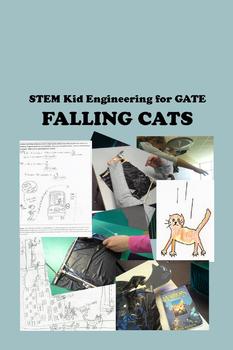STEAM Kid Engineering for GATE -- Falling Cats
Portable Gifted and Talented
3.1k Followers
Grade Levels
3rd - 6th
Subjects
Resource Type
Standards
CCSS5.MD.A.1
CCSS4.NBT.B.5
CCSS5.NBT.B.5
CCSS5.NF.B.4
CCSS5.NF.B.4a
Formats Included
- Word Document File
Pages
22 pages
Portable Gifted and Talented
3.1k Followers
Also included in
- None of these adventures appear in the STEAM CLASS CURRICULUM collection--a great supplement to your class at more than 33% off individual unit prices.Your kids will love these (part 1 of 2)! Tons of hands-on challenge and full of critical thinking—these eight units are heavily engineering and builPrice $16.99Original Price $22.47Save $5.48
Description
*This the STEM ONLY portion of the “Cats, Cats, Cats Across the Curriculum for GATE” lesson collection available in my store.
Shouldn’t your 21st Century classroom be just like today’s virtual world? In other words, shouldn’t it be full of cats?!
In this two lesson bundle you get instructions and photos, sample student work, ready-to-print activity sheets, Common Core and Next Generation Science references, and everything you need except the actual cats (you’ll be making your own!).
I’ve used these lessons with my 4th grade GATE group, but it should be appropriate for 3rd GATE through 6th grade.
Summary of Lessons:
“Mathematical Cats”—Math and Logic: Here is a ready-to-print activity to challenge your students with multi-step story problems concerning cats (25-35 minutes). This is good practice for the math portion of state testing.
“Falling Cats”—Science and Engineering; Speaking and Listening: In this activity, students practice listening skills with an interesting Radio Lab science broadcast about cats falling from New York skyscrapers. Students then express their understanding of the physical science of falling cats with pictures and words. Next, students build and test their own falling cat in a cool engineering project (3-4 hours).
Shouldn’t your 21st Century classroom be just like today’s virtual world? In other words, shouldn’t it be full of cats?!
In this two lesson bundle you get instructions and photos, sample student work, ready-to-print activity sheets, Common Core and Next Generation Science references, and everything you need except the actual cats (you’ll be making your own!).
I’ve used these lessons with my 4th grade GATE group, but it should be appropriate for 3rd GATE through 6th grade.
Summary of Lessons:
“Mathematical Cats”—Math and Logic: Here is a ready-to-print activity to challenge your students with multi-step story problems concerning cats (25-35 minutes). This is good practice for the math portion of state testing.
“Falling Cats”—Science and Engineering; Speaking and Listening: In this activity, students practice listening skills with an interesting Radio Lab science broadcast about cats falling from New York skyscrapers. Students then express their understanding of the physical science of falling cats with pictures and words. Next, students build and test their own falling cat in a cool engineering project (3-4 hours).
Total Pages
22 pages
Answer Key
Included
Teaching Duration
Other
Report this resource to TPT
Reported resources will be reviewed by our team. Report this resource to let us know if this resource violates TPT’s content guidelines.
Standards
to see state-specific standards (only available in the US).
CCSS5.MD.A.1
Convert among different-sized standard measurement units within a given measurement system (e.g., convert 5 cm to 0.05 m), and use these conversions in solving multi-step, real world problems.
CCSS4.NBT.B.5
Multiply a whole number of up to four digits by a one-digit whole number, and multiply two two-digit numbers, using strategies based on place value and the properties of operations. Illustrate and explain the calculation by using equations, rectangular arrays, and/or area models.
CCSS5.NBT.B.5
Fluently multiply multi-digit whole numbers using the standard algorithm.
CCSS5.NF.B.4
Apply and extend previous understandings of multiplication to multiply a fraction or whole number by a fraction.
CCSS5.NF.B.4a
Interpret the product (𝘢/𝘣) × 𝘲 as a parts of a partition of 𝘲 into 𝘣 equal parts; equivalently, as the result of a sequence of operations 𝘢 × 𝘲 ÷ 𝘣. For example, use a visual fraction model to show (2/3) × 4 = 8/3, and create a story context for this equation. Do the same with (2/3) × (4/5) = 8/15. (In general, (𝘢/𝘣) × (𝘤/𝘥) = 𝘢𝘤/𝘣𝘥.)



